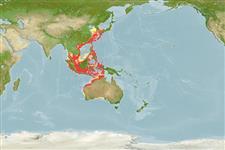Common names from other countries
>
Clupeiformes (Herrings) >
Dorosomatidae (Gizzard shads and sardinellas)
Etymology: Sardinella: Latin and Greek, sarda = sardine; name related to the island of Sardinia; diminutive (Ref. 45335).
More on author: Bleeker.
Environment: milieu / climate zone / depth range / distribution range
Ecologia
marinhas; oceanódromo (Ref. 51243); intervalo de profundidade 15 - 100 m (Ref. 12260). Tropical; 38°N - 33°S, 97°E - 134°E (Ref. 54869)
Eastern Indian Ocean: Phuket, Thailand; southern coasts of East Java and Bali; and Western Australia. Western Pacific: Java Sea, Philippines, Hong Kong, Taiwan Island, southern Japan. Can not be distinguished as yet on morphological grounds from Sardinella aurita which occurs in the Atlantic Ocean.
Comprimento de primeira maturação / Tamanho / Peso / Idade
Maturity: Lm 14.3, range 14 - 15 cm
Max length : 23.0 cm SL macho/indeterminado; (Ref. 188); common length : 20.0 cm SL macho/indeterminado; (Ref. 188)
Espinhos dorsais (total): 0; Raios dorsais (total): 13-21; Espinhos anais 0; Raios anais : 12 - 23. A faint golden spot behind gill opening, followed by a faint golden mid-lateral line; a distinct black spot at hind border of gill cover (absence of pigment). Body elongate, sub-cylindrical. Distinguished from all other clupeids in the eastern Indian Ocean and western Pacific by its pelvic fin ray count of i 8; from S. longiceps by its shorter head length and fewer lower gill rakers.
Adults form large schools in coastal waters, particularly in the Bali Strait upwelling. Found in sheltered bays and lagoons (Ref. 48635). They feed on phytoplankton and zooplankton, chiefly copepods. Time series analysis (Ref. 9586) suggests that recruitment fluctuations are related to ENSO events, as defined in Ref. 9577, 9578 and 9580.
Spawning tends to take place in inshore waters where salinity is low (Ref. 6863) at the beginning of the rainy season. Spawning aggregations may be formed, also including Amblygaster sirm, A. leogaster and Clupea fimbriata.
Whitehead, P.J.P., 1985. FAO Species Catalogue. Vol. 7. Clupeoid fishes of the world (suborder Clupeoidei). An annotated and illustrated catalogue of the herrings, sardines, pilchards, sprats, shads, anchovies and wolf-herrings. FAO Fish. Synop. 125(7/1):1-303. Rome: FAO. (Ref. 188)
Status na Lista Vermelha da UICN (Ref. 130435)
CITES (Ref. 128078)
Not Evaluated
Ameaça para os humanos
Harmless
Uso pelos humanos
Can't connect to MySQL database (fbapp). Errorcode: Too many connections
